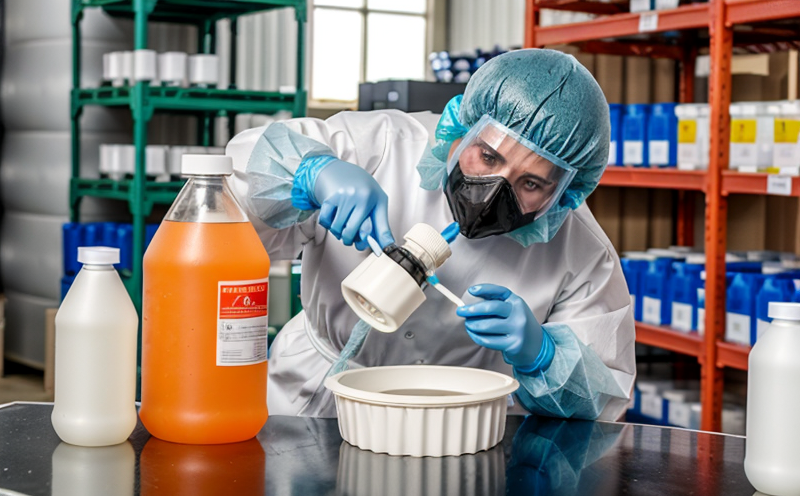ASTM F1929 Dye Penetration Microbial Integrity Testing of Packaging
The ASTM F1929 dye penetration microbial integrity test is a critical method used in the packaging industry to ensure that flexible packaging materials remain impermeable to microorganisms during food and beverage storage. This test evaluates the effectiveness of barrier layers within packaging, which are designed to prevent bacterial contamination from external sources.
The primary objective of ASTM F1929 testing is to determine whether a packaging material can maintain its integrity under various conditions that mimic real-world environments where microbial ingress might occur. The test involves applying a dye solution across the surface of the packaging and then subjecting it to specific temperature and humidity conditions. If microorganisms penetrate through the packaging, they will degrade the dye, which can be visually detected.
This method is particularly important for ensuring that packaging used in food and beverage industries meets regulatory requirements set forth by organizations such as FDA (Food and Drug Administration) and other relevant authorities worldwide. By conducting this test, companies can demonstrate their commitment to producing safe and hygienic products, thereby protecting consumer health and maintaining brand integrity.
The ASTM F1929 standard specifies detailed procedures for performing the dye penetration test, including preparation of the specimen, application of the dye solution, incubation conditions, and evaluation criteria. Compliance with these standards ensures that the results obtained are reliable and comparable across different laboratories.
One key aspect of this testing process is the use of appropriate media to both apply the dye and incubate the specimens. Typically, a compatible medium such as peptone water or nutrient broth is used for the dye application. After applying the dye, the specimen is placed in an incubator set at 37°C (98.6°F) under controlled humidity conditions that simulate typical storage environments.
The duration of this incubation period varies depending on the type of packaging material and its intended use; however, it usually lasts between 48 hours to one week. During this time, any breaches in the integrity of the packaging allow microbial activity within the dye solution, leading to visible discoloration or degradation.
Once the incubation period concludes, the specimens are inspected visually for signs of dye breakdown indicative of microbial penetration. A positive result would show distinct areas where the dye has been broken down by microorganisms present in the test environment. Conversely, a negative result indicates that no such breaches occurred, thus confirming the microbiological integrity of the packaging.
It's crucial to note that while ASTM F1929 focuses primarily on detecting microbial ingress through physical flaws or defects in the packaging structure, it does not address other potential pathways for contamination like those introduced during manufacturing processes or handling post-packaging. Therefore, when designing comprehensive quality assurance programs, manufacturers should consider incorporating additional tests alongside ASTM F1929 to cover all aspects of microbiological safety.
In conclusion, ASTM F1929 dye penetration microbial integrity testing is an essential tool for assessing the effectiveness of barrier layers within flexible packaging materials used in food and beverage industries. By adhering strictly to established protocols outlined by this standard, manufacturers can ensure compliance with regulatory requirements while enhancing consumer trust through demonstrably safe products.
Benefits
- Ensures microbiological integrity of flexible packaging materials
- Detects potential breaches in packaging integrity early on
- Supports compliance with international standards and regulations
- Enhances overall quality control measures within manufacturing processes
- Fosters consumer confidence by providing proof of safety against microbial contamination
Industry Applications
| Application Area | Description |
|---|---|
| Food and Beverage Packaging | Packaging materials for products like fruits, vegetables, meat, dairy items must meet stringent safety standards to prevent spoilage due to microbial activity. |
| Beverage Containers | Ensuring that containers used for carbonated drinks or alcoholic beverages remain free from bacterial contamination is vital given their high risk of rapid spoilage if compromised. |
| Pharmaceutical Packaging | For drug delivery systems, maintaining sterility throughout the supply chain is paramount. Any breach could lead to severe health risks for patients taking these medications. |
| Cosmetic Products | Microbiological safety testing helps guarantee that cosmetics remain stable and safe for consumers over extended periods without undergoing spoilage or contamination. |
Environmental and Sustainability Contributions
The ASTM F1929 dye penetration microbial integrity test plays a pivotal role in promoting sustainable practices within the packaging industry by helping manufacturers identify areas for improvement. By ensuring that packaging materials remain impermeable to microorganisms, companies can reduce waste associated with spoilage or contamination, ultimately leading to more efficient resource utilization.
In addition, adherence to rigorous testing protocols like ASTM F1929 encourages innovation in material science and engineering. Researchers are continually developing new types of barrier coatings that not only enhance microbial resistance but also contribute positively to the environment through their biodegradability or recyclability properties.
Moreover, by preventing premature spoilage caused by microbial activity, this testing method helps minimize food waste—a significant contributor to global environmental issues. When less food needs to be discarded due to contamination, fewer raw materials are required for replacement production, resulting in lower greenhouse gas emissions and reduced energy consumption across the supply chain.
Furthermore, the use of ASTM F1929 ensures that packaging solutions meet stringent sustainability benchmarks set forth by various regulatory bodies. This aligns with broader industry initiatives aimed at reducing environmental impact while still meeting consumer demand for safe, convenient products.





